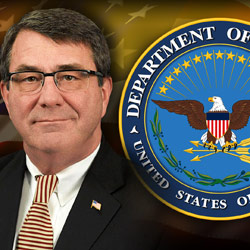Washington: Ashton Carter, nominee for the US Defence Secretary, was
instrumental in reviving India-US defence ties, a top American lawmaker
today said, while others welcomed his nomination for the top Pentagon
post.
“He (Carter) was instrumental in reviving the US-India defence relationship, a major development that continues to bear fruit, and he has helped forge new security ties with former Communist bloc nations,” House Democratic Whip Steny H Hoyer said after President Barack Obama nominated Carter.
Hoping that the Senate will confirm Carter quickly so he can get to work without delay, Hoyer said Carter is an excellent choice to serve the next Secretary of Defence.
“He has the experience and the judgment required to lead the Department of Defence as it confronts ISIL in Iraq and Syria, brings our troops safely home from Afghanistan, and counters threats against the United States and our allies around the world,” he said.
Congressman Mac Thornberry, Chairman-elect of the House Armed Services Committee, said Carter knows the Pentagon, and he knows that some reforms are essential if they are to meet the national security needs of the country.
Welcoming the nomination, Senator Jim Inhofe, ranking member of the Senate Armed Services Committee, said he has worked with Carter over the years and consider him qualified for the position and look forward to his confirmation hearing.
Senator John McCain said Carter is a highly competent, experienced, hard-working, and committed public servant.
“Throughout Carter’s previous tenure at the Pentagon, I have worked closely with him on a number of issues, including defence acquisition reform,” he said, adding that he was looking forward to his confirmation hearing.
Senator Lindsey Graham said Carter has the knowledge and capability to serve as Secretary of Defence during these difficult times.
“I expect he will face tough questions at his confirmation hearing about President Obama’s failing national security policy, but I expect he will be confirmed,” the Republican Senator said.
Senator Carl Levin, chairman of the Senate Armed Services Committee, said Carter is highly qualified and experienced, and well-versed in the challenges that the next secretary of defence will face.
“Carter understands the threats that confront our country and I believe his experience at the Pentagon will make him an effective leader for our military. Given the many critical national security issues confronting the United States, it is my hope that the Senate will work swiftly to consider and confirm President Obama’s nominee to this critical post,” Senate Majority Leader Harry Reid said.
Source : Defence News
“He (Carter) was instrumental in reviving the US-India defence relationship, a major development that continues to bear fruit, and he has helped forge new security ties with former Communist bloc nations,” House Democratic Whip Steny H Hoyer said after President Barack Obama nominated Carter.
Hoping that the Senate will confirm Carter quickly so he can get to work without delay, Hoyer said Carter is an excellent choice to serve the next Secretary of Defence.
“He has the experience and the judgment required to lead the Department of Defence as it confronts ISIL in Iraq and Syria, brings our troops safely home from Afghanistan, and counters threats against the United States and our allies around the world,” he said.
Congressman Mac Thornberry, Chairman-elect of the House Armed Services Committee, said Carter knows the Pentagon, and he knows that some reforms are essential if they are to meet the national security needs of the country.
Welcoming the nomination, Senator Jim Inhofe, ranking member of the Senate Armed Services Committee, said he has worked with Carter over the years and consider him qualified for the position and look forward to his confirmation hearing.
Senator John McCain said Carter is a highly competent, experienced, hard-working, and committed public servant.
“Throughout Carter’s previous tenure at the Pentagon, I have worked closely with him on a number of issues, including defence acquisition reform,” he said, adding that he was looking forward to his confirmation hearing.
Senator Lindsey Graham said Carter has the knowledge and capability to serve as Secretary of Defence during these difficult times.
“I expect he will face tough questions at his confirmation hearing about President Obama’s failing national security policy, but I expect he will be confirmed,” the Republican Senator said.
Senator Carl Levin, chairman of the Senate Armed Services Committee, said Carter is highly qualified and experienced, and well-versed in the challenges that the next secretary of defence will face.
“Carter understands the threats that confront our country and I believe his experience at the Pentagon will make him an effective leader for our military. Given the many critical national security issues confronting the United States, it is my hope that the Senate will work swiftly to consider and confirm President Obama’s nominee to this critical post,” Senate Majority Leader Harry Reid said.
Source : Defence News






